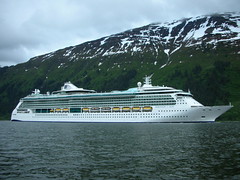 I’ve been reading with interest the latest flurry of blog posts on the subject matter that famous blogs don’t have the social bookmarking icons that many other blogs have. The inciting post was written by 37 signals and specifies that content is what matters and icons diminish the quality of your blog (the writer so eloquently put it as making your site “look cheap.”)
I’ve been reading with interest the latest flurry of blog posts on the subject matter that famous blogs don’t have the social bookmarking icons that many other blogs have. The inciting post was written by 37 signals and specifies that content is what matters and icons diminish the quality of your blog (the writer so eloquently put it as making your site “look cheap.”)
The most notable comment was:
Zero out of Technorati’s top 10 blogs feature those icons. And only two out of the 15 entries in the current crop at Digg’s Top Today page offer “Digg me” icons.
A few of my favorite bloggers responded, some with mixed emotions and others with outright negativism. I can’t say I’ve seen a post in support of what Matt at 37signals said (so I’ll applaud him for his link baiting efforts most notably defined by Lesson 2: “Controversy will incite passion. Passion drives links.”)
Darren Rowse of Problogger read the thread with interest and didn’t know what to make of it. I happen to be contemplating the value of these social bookmarking icons myself, but I think that Darren does doubt the power of them a lot more than I do (and I’m certainly not as popular as he is!)
Rand Fishkin outright considers the 37signals blog posting “awful” and points out that there are a variety of benefits to having these icons on your site — and costs too. Rand says that the presence of social bookmarking icons or links makes bookmarking to these sites easier, you’re encouraging the use of social bookmarking tools, and you’re hinting to others that you want to be bookmarked. He points out two downsides: you may appear to be too self-promotional and you’re deemphasizing the value of more important postings.
I agree with Rand and I wanted to expound a bit.
First, allow me to take a stab at Matt’s comments comparing the rest of the world to the top 10 on Technorati. Better yet, let’s look at Darren’s metrics where he says that the top 100 blogs on Technorati have an average age of 33.8 months. Upon doing research on the top blogs today, I’ve found the following:
- Engadget: Founded in March 2004, according to Wikipedia
- Boing Boing: First blog post: January 21, 2000
- FC2: First post: October 16, 2004
- Gizmodo: First post: circa February 2002 (02/2002 is linked from their archive page, but I don’t see any content)
- Sina Blog: First post: October 25, 2005
- The Huffington Post: From the tagline — “Delivering News and Opinion since May 9, 2005”
- TechCrunch: Founded on June 11, 2005
- Daily Kos: Established sometime in 2002
- Postsecret was founded on January 1, 2005
- Lifehacker: First post was on January 29, 2005
My point? Blogs take time to get to the top. Technorati is tracking 56.8 million blogs, and the top ten have been around for a year of more. All of them seem to have a dedicated staff (though I don’t know about the two blogs in Asia, as I can’t read in those languages). That puts the top blogs above 97% of blogs that are written by a single individual — and on a not-as-frequent basis as the top 10 Technorati blogs.
What does that go to show? Well, two things —
- New blogs can benefit from social bookmarking, and social bookmark companies can benefit from new blogs. Someone who Diggs your blog post will get your blog exposure, if even a little. A few of my blog posts have gotten 5-6 Diggs — granted, a small number compared to the more popular Digg posts — but it meant that new people may have visited my blog and may have added it to their RSS feed. Additionally, similar to what Rand said, you are showing that you are a devotee of these sites, thereby supporting them and their purpose. This drives traffic to the social bookmarking sites, and that can drive traffic to your site.
- The presence of the bookmarking links/icons help others help you — and it’s convenient. The convenience of the accessibility is definitely preferred by this particular individual (yes, I’m talking about me). Without the bookmarking links, a user has to log into their desired social bookmarking site, submit the URL/title/description, and click submit. Many people do prefer the ease of one-click-gets-you-there.
Truthfully, I think Matt at 37signals was off the mark to compare the majority of blogs to the top 10 at Technorati and Digg — both of which are heavily technology-centric. Blogs that are not as technology-oriented and are complex in scope typically don’t have as many Diggs as those that are. Darren questioned the viral quality of his polarizing filter post that wasn’t Digg’d as heavily as his DSLR camera blog post, but as a photographer myself (my own photography blog is at photocritique.us), I agree with Darren that the quality of both posts was good. If I could scrutinize and compare the two posts, I’d say that the former post with less Diggs probably had something to do with the blog post itself not being as technology-niched and more photographically advanced than the average technology-geek is looking for. The DSLR camera post is on the money — it’s a true beginner’s post and a stepping stone into something more photographically advanced. The average Digger and Technoratist is looking for those “howto” guides that open doors — but if the door isn’t open, then they aren’t going to Digg that post that seems above and beyond what they are capable of doing (for the time being). General how-to posts seem to fare better than others on Digg.
I think Matt’s assessment is generally flawed. Just because the people on the top are not as dependent upon social bookmarking as the rest of us doesn’t mean the rest of us shouldn’t use it. Social bookmarking links can help push those blogs to the top. I emphasize this comment that was posted in response to Darren by John Smulo:
I think the 37 Signals post makes a false comparison. Just because the top 10 on Technorati doesn’t use these tools, it doesn’t necessarily mean that blogs with smaller readership shouldn’t use them.
Blogs that get a lot of traffic will likely continue to get a lot of traffic if they continue to post helpful content. But they obviously didn’t get to this situation overnight. Quite possibly they used these types of tools earlier on and this was a significant part of what helped their blogs become what they are today.
However, my thought is that blogs with less traffic, and especially new bloggers, have to post great content *and* use some well-thought out tools to kick start greater traffic.
Those top Technorati blogs flourished over time. A regular readership brings many blogs to the top of Digg. Smaller blogs should have those social bookmarking tools to encourage others to make these blogs known.





You’re not limited to the same icons that everyone else uses. I had custom ones designed for my new layout and reccommend adding the digg button via the plugin whenever you’re making a serious run at digg.
Thanks Quadszilla. Your new layout is nice and those buttons are pretty sweet too. I actually have integrated the Digg button (and status indicator) onto my site — but I’m not quite there yet. 🙂
By the way, I should mention that my buttons are powered by the Socaible WordPress plugin, and I’ve also been a big fan of Lee Odden’s Social Bookmarks, particularly the drop-down list.